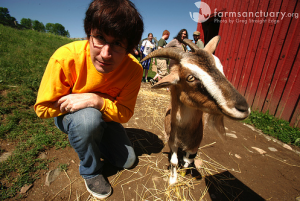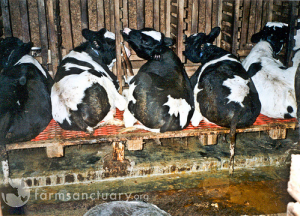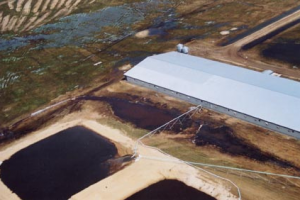
Why Go Vegetarian
Part 1 of 5
When I announced this new and improved blog, several people responded asking for an introduction to vegetarianism. I’m happy to oblige. Today starts the first in a five part series that will guide you through the journey of living a vegetarian life for your health, the animals, and the planet. The five parts will provide overviews on:
- part 1: why go vegetarian;
- part 2: how to go vegetarian;
- part 3: vegetarian nutrition;
- part 4: talking the vegetarian talk; and
- part 5: living a compassionate vegetarian life.
Just to preface, when I say vegetarian, I mean vegan as well. To me, you can not truly be supporting animal welfare -which is the main reason I’m vegan – unless you remove all animal products from your diet and lifestyle. However doing something is better than doing noting. If all you can do is cut out chicken in your diet, that’s better than continuing to eat chicken in addition to drinking milk, etc. It also appears that the word “vegetarian” is less difficult for people to accept. For some “veganism” seems too difficult to achieve. Regardless, it’s not about the labels or whatever you decide to call yourself, it’s about the intention you use to make your food choices every day.
Why Become Vegetarian?
There are so many reasons to become vegetarian! The main three are: for your health, for the animals, and for our planet.
For Your Health

Healthy vegetarian and musician, John Darnielle, with Zoop at Farm Sanctuary.
America is experiencing an obesity epidemic. More than one-third of U.S. adults were obese in 2005–2006. This includes 33.3% of men and 35.3% of women1. For the first time in history this generation of children is predicted to have a shorter life span than their parents due to obesity and obesity-related diseases. Vegetarianism, if managed well, is one way to combat obesity. You see the plants and grains do not contain the saturated fats and cholesterol found in animal products. So by choosing vegetarianism, you are virtually eliminating the unnecessary saturated fat and cholesterol from your diet. Dr. Michael Greger, an expert in nutrition, has done extensive research and found that several medical studies link meat consumption with breast cancer, bladder cancer and pancreatic cancer2. He has also shown that eating just one egg a day can lead to cardiovascular disease3. On average vegetarians have lower body weight, cholesterol, and blood pressure, and lower rates of type 2 diabetes, heart disease, prostate cancer, and colon cancer4. Furthermore, the animals raised for food are pumped full of antibiotics, hormones and toxins that eventually reach their human consumers. Dairy is notorious for containing an excess of sex steroids which some claim to cause early onset puberty and breast cancer in women. The National Institute of Health has reported alarming levels of arsenic in chicken breast, six times the amount allowed in drinking water5. Once we understand that eating animal products is a packaged deal, meaning that while they may offer benefits to human health the bad effects far outweigh the good, it seems clear that we should rely on plants, beans, and grains to meet our nutritional needs. These food sources do not have such drastic consequences to human health or animal welfare. After all, the animals get their nutrients from the plants they eat. Then we expect them to pass those nutrients on to us. But we can do something better. We can start from the beginning and shorten the food chain by deriving nutrition from plant-based sources. It’s better for our health.
For The Animals

Male "dairy" cows are used for veal because they can not produce milk.
Most of our food in America comes from factory farms. Americans eat a lot of food which means 10 BILLION6 (yes billion, that’s not a typo) animals are killed for food each year. That equals 1,140,901 animals per hour. This number includes cows, pigs, chickens, turkey, and other animals raised for food. It does not include fish or game. These animals are treated horribly on factory farms. Female pigs used for breeding (called ‘breeding sows‘ by industry) are confined most of their lives in ‘gestation crates’ which are so small that they can not turn around. The same goes for veal calves (little boys that are a byproduct of the dairy industry) who are not only confined but also chained by their neck so they can not move. Female dairy cows are constantly impregnated so they can continue to produce milk and veal. They often suffer painful inflammation of their utters from producing extreme quantities of milk. Most beef cattle spend several months in congested feedlots where they are fed unnatural diets and exposed to freezing and extremely hot temperatures without shelter. Chicken – the majority of animals killed – are kept in cages so small they can not move, spread their wings or socialize like they would naturally. Male chicks, like male dairy cows, have no place in the egg industry. Over 30 million male chicks are ground up alive each year7. ALL of these animals (aside from the male chicks) are sent to slaughter which is not pretty. Death is never a beautiful thing when the animal you are killing desperately wants to live. Because so many animals die each year for food production, they are sent quickly through the slaughter lines meaning that sometimes they are alive and conscious when they reach the hide puller or tail ripper. There are many other atrocities committed against the animals humans eat. This is but an overview. So I ask you … if you would not treat animals this way, why would you pay someone else to so that meat can end up on your table?
For Our Planet

Manure waste from a confined animal feeding operation.
The production of animals is a major contributor to the destruction of our environment. Factory farming produce toxins, chemicals, gases, and uncontainable amounts of manure that pollute the soil, water, and air. This causes masses environmental degradation and can be dangerous to public health. According to the Food and Agriculture Organization of the United Nations, “The livestock sector is a major player responsible for 18 percent of green-house gas emissions measured in CO2 equivalent. This is a higher share than transport.”8 Eating a meal with meat requires 16 times the amount of fossil fuels to produce than a vegetarian meal9.In addition, it takes an enormous amount of resources to raise animals for food and eat them. It is more efficient to raise grains and plants for humans to eat rather than to raise grains and plants for animals to consume and then for people to consume the animals. It takes 14 times more energy and 40 percent more cropland to produce the protein found in chicken meat as is does to produce the same amount of protein per unit of soybeans10. The Worldwatch Institute says, “As environmental science has advanced, it has become apparent that the human appetite for animal flesh is a driving force behind virtually every major category of environmental damage now threatening the human future – deforestation, erosion, fresh water scarcity, air and water pollution, climate change, biodiversity loss, social injustice, the destabilization of communities, and the spread of disease”11. Even Al Gore and Glenn Beck say the single most important thing you can do to stop global warming is to stop eating meat.
Types of Vegetarians
There are different types of vegetarians. These are the most common.
Vegetarian: A vegetarian is a person who does not eat meat but eats animal byproducts such as milk, cheese and eggs.
Lacto-vegetarian: A lacto-vegetarian is a person that does not eat eggs but does eat dairy products.
Ovo-Vegetarian: An ovo-vegetarian is a person that do not eat meat or dairy products but does eat eggs.
Lacto-Ovo Vegetarian: Lacto-ovo vegetarian is a person that does not eat meat but they do eat milk, cheese and eggs. They are the most common type of vegetarians in the Western world.
Vegan: A vegan is a person who does not eat meat or animal byproducts, A vegan also rejects the use of animal products such as leather, silk, wool in clothing and household goods.
Raw Vegan: A raw vegan is a person who eats only raw, vegan foods. “Raw” means that the food has not been heated above 115 degrees Fahrenheit. Raw vegans believe that foods cooked above this temperature loses a significant amount of their nutritional value.
Think about what kind of vegetarian you would like to be. Our next step in part 2 will be discussing how to make the transition from a typical meat-eating diet to one of compassion and fulfillment that minimizes the suffering of both animals, the planet and people.
Resources
1. Centers for Disease Control and Prevention, Obesity Among Adults in the United States, http://www.cdc.gov/obesity/index.html
2. Dr. Michael Greger, Latest in Clinical Nutrition DVD, volume 2, http://www.drgreger.org/DVDs/
3. Dr. Michael Greger, Latest in Clinical Nutrition DVD, volume 2, http://www.drgreger.org/DVDs/
4. American Dietetic Association, Vegetarian Diets, Volume 109, Issue 7, Pages 1266-1282 (July 2009), http://www.eatright.org/cps/rde/xchg/ada/hs.xsl/advocacy_933_ENU_HTML.htm
5. Lasky T, Sun W, Kadry A, and Hoffman MK, “Mean Total Arsenic Concentrations in Chicken 1989-2000 and estimated Exposures for Consumers of Chicken,” Environmental Health Perspectives 112(1), Jan. 2004.
6. The Humane Society of the United States: Guide to Vegetarian Eating based on USDA, National Agricultural Statistics Service.
7. Mercy for Animals, Hatchery Horrors: The Egg Industry’s Tiniest Victims, http://www.mercyforanimals.org/hatchery/
8. Livestock’s Long Shadow, Food and Agriculture Organization of the United Nations, http://www.fao.org/docrep/010/a0701e/a0701e00.HTM
9. Gene Baur, Farm Sanctuary, during a talk at Changing Hands Bookstore in Tempe, Arizona on March 30, 2009.
10. The Humane Society of the United States: Guide to Vegetarian Eating based on USDA, National Agricultural Statistics Service, “Poultry Slaughter: 2006 Annual Summary”.
11. Is Meat Sustainable?, Worldwatch Institute, http://www.worldwatch.org/node/549


















